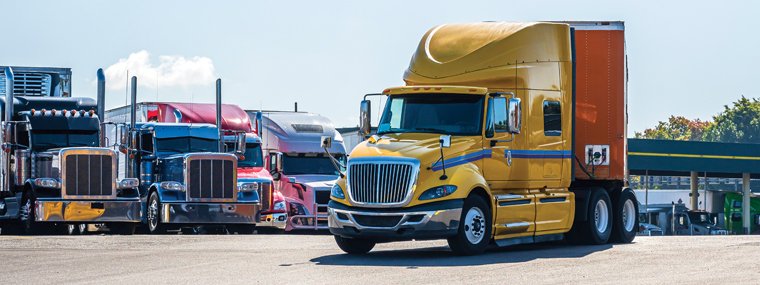
Two-Step Cleaning
By Diane M. Calabrese / Published May 2020

Two-step cleaning? Is it still in use? Indeed, it is.
There have been changes, such as a move to less dangerous acids in the lowest possible concentrations, but the concept remains the same: Application of an acidic solution followed by an alkaline solution does the tough work of removing the oil and grease—and all manner of embedded debris, from carbon to pollen—from a surface. It’s a real boon to cleaning the dirtiest of all vehicles, such as an 18-wheeler that just traversed the Pennsylvania Turnpike in winter. (Salt and cinder still counter ice and curves on that route.)
Having changed the focus of his operation, Skip Markowitz, owner of EDI Distributors Inc. in Cherry Hill, NJ, has not been involved in making equipment for two-step cleaning in some time. But he recalls that 25 years ago in the early years of his business, he made as many as 100 machines in a month.
An engineer by training, Markowitz recalls the advent of the two-step process as a genuine breakthrough. “It was real labor savings at the time,” he says.
Across the years, the two-step method has both been constrained and made better by environmental regulations. Markowitz sees the regulations as logical and a doubly good thing because they spur innovation.
Some of that innovation has led to optimizing use of acids. For example, tissue-penetrating hydrofluoric acid, which is particularly deadly in hydrous and vapor forms, is nearly out of use in the cleaning sphere. (Many industrial processes still require it.)
Largo Cleaning Systems in Decaturville, TN, which is owned by Steve Tolley, is one of the makers of two-step machines going full throttle today. The company’s machines exemplify the attention to the environment that aligns with the two-step process, as precision chemical injection is built into its machine—making it economical and environmentally friendly.
Manufacturers of two-step systems have refined them to the extent that it’s not just one acid solution for step one and one alkaline solution for step two (neutralization). A contractor can choose preparations tailored to composition of the surface and types of soiling (i.e., the mix of oil, grease, carbon, insects, salt).
In fact, the attention to the environment may boost adoption of two-step cleaning for many reasons: The process reduces water use. It uses the smallest amount of chemical possible. Clean vehicles are more aerodynamic.
And what about the term twin-chem? It, too, has been used as a descriptor of the acidic solution followed by alkaline solution process. And the article “Two-Step’ or ‘Twin-Chem’ Truck Washing” in the EnviroSpec articles for contractors’ series recounts some history of the development of the process (envirospec.com/two-step-twin-chem-truck-washing.)
Getting Reacquainted
Although interest in two-step cleaning has always been present, it has experienced a wider adoption in recent years. Put “environmentally friendly” on the list of reasons for an increase in interest, says Terry Craycraft, North America business development manager at Hydro-Chem Systems Inc. in Caledonia, MI.
“When you apply a low pH presoak—first step—followed by a high pH detergent—second step—and then rinse, the runoff water coming off the fleets or equipment will be near neutral on the pH scale,” explains Craycraft. “Remember, 0 to 14 is the pH scale, and water has a rating of 7 or ‘neutral.’”
Reasons related to the way the method bolsters the bottom line also explain interest. “Companies are looking at ways to be more efficient when washing their own fleets; or if you are a mobile fleet washing company, they are looking to have less labor costs because it’s tough to find good people to work for them,” says Craycraft. “Brushing fleets take a lot of labor and time, which are expenses to the mobile fleet washing company.”
The gains in speed translate to growth opportunities for companies. “Two-step fleet cleaning systems allow mobile fleet washing companies to scale and grow their business quickly while keeping their labor costs at a minimum,” explains Craycraft.
For companies that wash private fleets in-house, the two-step system offers something more. “They are able to clean more pieces of equipment each day, which will allow them to keep their image looking good,” says Craycraft. And that’s all accompanied by “lower maintenance costs, less risk of being pulled over by the DOT for a dirty truck or trailer, and an outcome that builds drivers’ pride.”
Lower labor expense is significant with the adoption of two-step cleaning. It is cut to 40 and 70 percent when compared to brushing, explains Craycraft.
“There are many ways a two-step cleaning system improves cleaning outcomes,” says Craycraft. “Washing more accounts in less time equals a higher ROI [return on investment] for them,” says Craycraft. It also is the “most consistent way to achieve road film-free results week after week” and to do so without the risk of inflicting micro-abrasions on painted surfaces with brushes.
Chemicals have a place in cleaning. Regulators understand legitimate and conscientious deployment. “Using the proper chemicals while being educated on them will allow your company to achieve consistent cleaning results, and your fleet or customer will be very happy,” says Craycraft. “The most important thing when you are going to use chemicals to clean something is to purchase your chemicals from the manufacturer or approved distributor of the manufacturer of those chemicals. You will be properly educated on them and know how to use the chemicals to your and your customer’s benefit.”
Contractor’s Insight
“Speed and labor savings are definitely the biggest advantage” of two-step, says Daniel Hopson, owner of Cleaner Image Mobile Pressure Washing in Johnson City, TN. “Over the past few years, a lot seems to have changed in the way we wash.”
Hopson explains that things change quickly. At age 45, he recalls that when he was a boy, gas-powered machines were rare in Upper East Tennessee because they were considered expensive.
It’s not just the power source on the machine that has changed. So, too, have the techniques.
“Nowadays, you can choose from original two-step systems with or without remote control, Dema valves, foamers, and the old-fashioned downstream injection by swapping from brightener to soap,” says Hopson.
“Over the years I found that the most reliable way is to use a downstream injector,” says Hopson, “the reason being that employees are not as loving and caring for my equipment as I am. Downstreamers are cheap and easy to replace on the weekends when most fleet washing occurs.”
Despite his preference, Hopson recognizes contractors may have a different perspective. “Everyone has an opinion on the correct method of washing trucks, but honestly, I believe whatever works best for you is the method to use,” he says.
Some of the choice may be dependent upon the workforce available. “At the present I am down to almost a one-man operation—mostly myself and sometimes an extra man on the weekends,” says Hopson. One of the factors accounting for the lean roster is the difficulty of getting good employees.
“One last thing to add, there has never been a truer saying than ‘a good soap is cheaper than good help,’” says Hopson. “So honestly, two-stepping is faster and cheaper because it decreases the amount of brushing that needs to be done.”
Chemicals used correctly have a significant role to play in cleaning, we all agree. Hopson expresses the concern we share that it’s not the chemicals themselves, but those who use them incorrectly that cause problems. He advocates that individuals new to contracting seek the best advice from industry professionals.
“Honestly, I am not sure if anything other than the fleet washing industry uses a two-step process,” says Hopson. “I’m sure operations like dairy farms and food processors could benefit from a two-step system—just using different chemicals, of course.”
Hopson is onto something. Many disparate settings are in search of cleaning processes that involve an analog of the two-step acid and alkaline approach of our industry’s two-step.
Hospitals confront more and more difficulties in removing drug-resistant microbes from surfaces. No less exacting are the needs of NASA. All sorts of cleaning take place that involve a sequence in two steps. Soap followed by a water rinse is two steps. At the other extreme is a two-step method that can be used by NASA to clean oxygen systems, which deploys a flammable solvent to clean followed by a nonflammable solvent to rinse.
NASA has been grappling with finding a substitute for HCFC-225 since the mandatory EPA phase-out of the hydrofluorocarbon began in 2014. A good solvent that is thermally stable, has low acute toxicity, and is an excellent vapor degreaser—HCFC-225—is not easy to replace. But an intense search is on.
Just as NASA will find a replacement method for cleaning large propulsion oxygen systems, our industry will continue to develop more refined methods of cleaning that minimize use of chemicals and water and maximize good outcomes. A two-step (acid, alkaline) method is a perfect demonstration of that.





